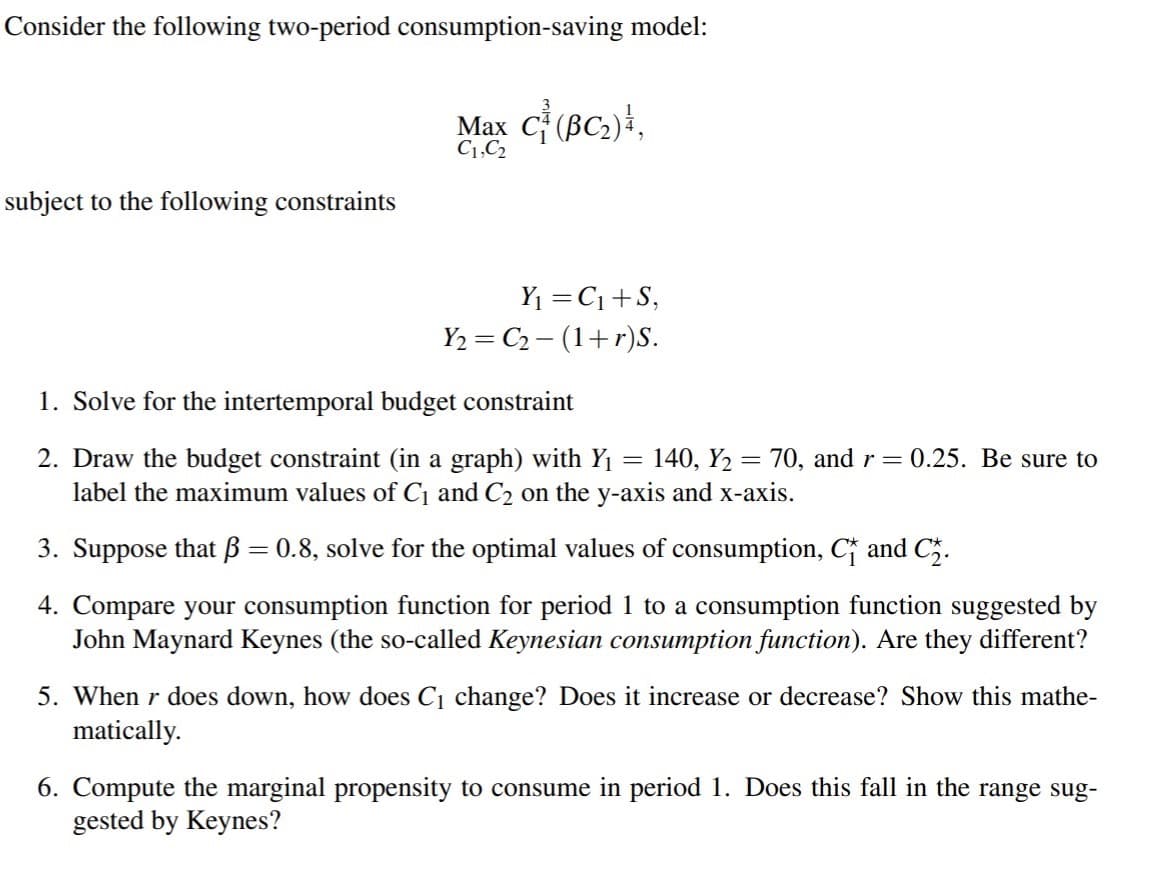Consider the following two-period consumption-saving model: Max C (BC2), C1,C2 subject to the following constraints Y1 =C1+S, Y2 = C2 – (1+r)S. 1. Solve for the intertemporal budget constraint 2. Draw the budget constraint (in a graph) with Y1 = 140, Y2 = 70, and r = 0.25. Be sure to label the maximum values of C1 and C2 on the y-axis and x-axis. %3D 3. Suppose that ß = 0.8, solve for the optimal values of consumption, C and C3. %3D 4. Compare your consumption function for period 1 to a consumption function suggested by John Maynard Keynes (the so-called Keynesian consumption function). Are they different? 5. When r does down, how does C1 change? Does it increase or decrease? Show this mathe- matically. 6. Compute the marginal propensity to consume in period 1. Does this fall in the range sug- gested by Keynes?
Consider the following two-period consumption-saving model: Max C (BC2), C1,C2 subject to the following constraints Y1 =C1+S, Y2 = C2 – (1+r)S. 1. Solve for the intertemporal budget constraint 2. Draw the budget constraint (in a graph) with Y1 = 140, Y2 = 70, and r = 0.25. Be sure to label the maximum values of C1 and C2 on the y-axis and x-axis. %3D 3. Suppose that ß = 0.8, solve for the optimal values of consumption, C and C3. %3D 4. Compare your consumption function for period 1 to a consumption function suggested by John Maynard Keynes (the so-called Keynesian consumption function). Are they different? 5. When r does down, how does C1 change? Does it increase or decrease? Show this mathe- matically. 6. Compute the marginal propensity to consume in period 1. Does this fall in the range sug- gested by Keynes?
Chapter18: The Keynesian Model
Section: Chapter Questions
Problem 9SQP
Related questions
Question
I need tuto,rs for Macroecon
Con,tact me by go,ogle id : mageexyz

Transcribed Image Text:Consider the following two-period consumption-saving model:
Max C (BC2)},
C1,C2
subject to the following constraints
Y1 = C1+S,
Y2 = C2 – (1+r)S.
1. Solve for the intertemporal budget constraint
2. Draw the budget constraint (in a graph) with Y1 = 140, Y2 = 70, and r=0.25. Be sure to
label the maximum values of C¡ and C2 on the y-axis and x-axis.
3. Suppose that ß = 0.8, solve for the optimal values of consumption, C and C5.
%3D
4. Compare your consumption function for period 1 to a consumption function suggested by
John Maynard Keynes (the so-called Keynesian consumption function). Are they different?
5. When r does down, how does C1 change? Does it increase or decrease? Show this mathe-
matically.
6. Compute the marginal propensity to consume in period 1. Does this fall in the range sug-
gested by Keynes?
Expert Solution
This question has been solved!
Explore an expertly crafted, step-by-step solution for a thorough understanding of key concepts.
Step by step
Solved in 2 steps with 4 images

Knowledge Booster
Learn more about
Need a deep-dive on the concept behind this application? Look no further. Learn more about this topic, economics and related others by exploring similar questions and additional content below.Recommended textbooks for you





